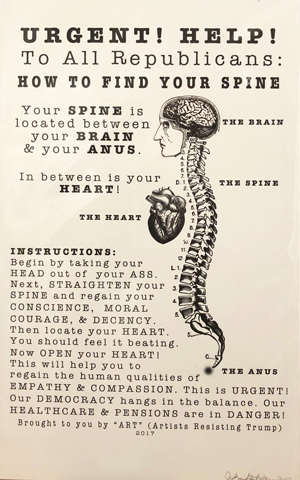
In this age of politics as warfare by other means, 16 contemporary Michigan artists have joined together to engage the enemy in Outrage, an exhibition of political art at 22 North Gallery in Ypsilanti from October 6 – 27. The views expressed in this polemic exhibit go from left-of-center to far-far-left, and the mood ranges from existential dread to red-eyed anger to comic despair.

Outrage was organized and curated by 3 like-minded artists, Susan Fecteau, John Gutoskey and Leslie Sobel, all of them politically active. Fecteau is noted in the area for her humorous but pointed political comments chalked on sidewalks outside the Ann Arbor residence of Governor Rick Snyder. Leslie Sobel is a longtime climate change artist-activist and John Gutoskey is a painter and printmaker whose focus is LGBT rights. “The three of us met together with other artists in January, [2017] to talk about what we …could do in response to what seemed like the coming apocalypse,” says Sobel. “We weren’t really sure what we would get,” adds Gutoskey.

Sobel comments about the work in the gallery, “It’s an interesting mix because there are artists in this room… who don’t normally do political work, and who have felt moved to do political work and there are some of us who have done political work as the subtext but not necessarily overtly in-your-face all of the time and some of it is very much in-your-face all of the time.”
Susan Fecteau’s art practice reflects her strong and ongoing activism, and goes from the nuts-and-bolts creation of signs for demonstrations to more object-driven expressions of her political views. She describes her ongoing sign-making project: “As artists, we felt we could really help people make effective signs, and probably the best thing we did was provide materials. I scrounged a couple of truck loads of card board and we got sticks and paint… so we invited people to come over prior to any significant local protests, [and] we have continued that work.”

Humor is employed throughout the exhibit in the service of political protest. Margaret Parker’s t-shirt design delivers a hilarious primal scream –or maybe a shout-out –for those of us who just can’t take it any more. Wooden boxes by John Gutoskey are well crafted, icy satire, and his posters are equally pointed and funny. Sam G. Fecteau Brown’s graffiti-encrusted toy trains and Val Mann’s embroidered vintage baby clothes are a softer, but no less urgent, expression of disquiet at this political moment. The sculpted head of Joan Painter Jones’ Martyr 4 has the horrified gaze of someone who’s seen way too much, and Terri Sarris’s freak show-inspired box World’s Smallest Man effectively skewers its ridicule-worthy target. Jack Summers’s collage practically jumps off the wall, spitting and screaming.
Throughout history, artists from Goya to Picasso to Leon Golub and many more have used art to make political points, even though doubts linger about its effectiveness in changing attitudes or affecting political outcomes. Art like the work in Outrage may serve more as encouragement to like-minded viewers, and to reinforce the values of fellow liberals without reaching or influencing political opponents, which makes it no less valid. Leslie Sobel sums it up: “I think it matters. I think expressing [our political beliefs] in more ways than just showing up to demonstrations and picketing and voting is important. I think it makes a difference and it’s certainly the skill set that many of us in this room have. I do hope it’s effective in keeping the issues in the front of peoples’ minds.”
The artists in Outrage are: Sam G. Fecteau Brown, Alejandro Chinchilla, Liz Davis, Susan Fecteau, John Gutoskey, Joan Painter Jones, Esther Kirschenbaum, K.A. Letts, Val Mann, Brenda Miller, Margaret Parker, Christine Valentine Reising, Theresa Rosado, Terri Sarris, Leslie Sobel, Jack Summers.















